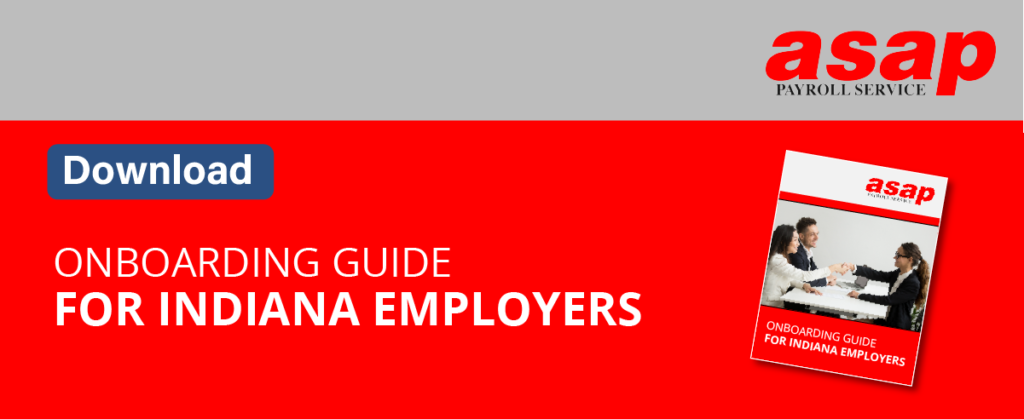If you’re a newly established business in Indiana and planning to hire employees, it’s important to have an understanding of Indiana payroll regulations. To help you learn how to set up payroll in the state of Indiana, we’ve created this guide for new Hoosier-state businesses.
Indiana Payroll Guide: Need to Know
The first thing you need to know is that businesses in Indiana that plan to hire employees must register with the state in INBiz. You’ll need to fill out the WH-3 and BT-1 forms. There is a $25 fee associated with the Retail Merchants Certificate. INBiz allows Indiana businesses to register their names and file all the required forms.
- Indiana’s minimum wage is $7.25 an hour for non-tipped employees and $2.13 for tipped employees, which is the same as the federal government.
- If you hire individuals who are under the age of 18, they no longer need work permits. However, you will still need to adhere to the teen work hours.
- Indiana has tax reciprocity with Kentucky, Michigan, Ohio, Pennsylvania, and Wisconsin, which means income earned in these states by residents of Indiana must be reported as Indiana income.
1. Set Up Payroll In Indiana
Once you create your account and fill out the required forms, you must set up your payroll process. Setting up payroll in Indiana involves setting up a payroll process and scheduling regular paydays. In Indiana, employees must be paid at least twice a month. Employees must receive their final paycheck within three business days if they are terminated or quits their job.
2. Collect Employee Data
To process your payroll, you’ll need to have your employees fill out certain payroll forms to determine their eligibility to work and to ensure the proper deductions are made from their paychecks.
- WH-4 – This is the employee’s county status certificate and withholding exemption form.
- WH-4MIL – This form is for military spouses who are non-residents.
- WH-47 – This form is used when your employee lives in a reciprocal state but works for your Indiana business.
- W-4 – Withholding form for federal tax
- W- 9 – A federal tax form that is used to ensure that a person’s taxpayer identification number, name, and address are correct.
- I-9 – Form used to check employment eligibility
- WOTC – The work opportunity tax credit form
- Direct Deposit Information – If you plan to pay your employees via direct deposit, you’ll need their bank account information on file.
3. Collect Employee Timesheets
Pay is determined in two ways. You either pay your employees hourly or via a salary. Salaried employees are typically exempt from overtime and must receive at least $35,568 annually. These employees are not required to track their hours. Though, some employers may prefer it.
On the other hand, hourly employees must track their hours to ensure they are being paid for every hour they work and receive all of their required breaks. Hourly employees who work more than 40 hours a week are entitled to time and a half after 40 hours.
While you can still use paper timesheets or timeclocks that employees punch in and out on, many employers are moving to digital timesheets, apps, and GPS to track hours. Apps and time-tracking software help to automate hour tracking.
These pieces of software can prompt employees to clock in and out for shifts and breaks. GPS software can be used to clock employees in and out when they enter and leave a certain area. This results in fewer errors.
4. Calculate Your Employees’ Paychecks
You’ll need to calculate your employees ‘ paychecks once you reach the end of a pay period. The check amount should indicate the gross amount they were paid and all the applicable deductions.
Then, the employee should be paid their gross pay minus the deductions, which is their net pay.
Most employees will have federal income tax, social security tax, Medicare tax, and state income tax deducted from their pay. Individuals may also have other things deducted from their pay, like insurance premiums and garnishments.
5. Pay Your State and Federal Withholding Taxes
Lastly, you’ll need to pay your federal and state withholding taxes. In 2024, the federal government is changing the withholding pay schedule. Employers can choose monthly or semi-weekly, and you must declare which payment plan you intend to use.
Businesses in Indiana must file the WH-1 and WH-3 forms by January 31st of each year, regardless of whether or not they paid any withholding taxes. If a business does pay withholding taxes, it must file a WH-1 by certain due dates.
For employers that qualify, that may be yearly, monthly, or quarterly. Employers can also opt to pay withholding taxes early, which is 20 days after the monthly filing period. Quarterly payments are paid on the last day of the month following the completed quarter. If a business intends to pay monthly, they must pay within 30 days after the end of the filing period month. Yearly payments should be made by January 31st of the next year. Indiana business can pay their taxes using INTIME.
Let ASAP Payroll Help You with Your Payroll Processing
If setting up payroll in Indiana sounds confusing and you’re worried about Indiana payroll compliance, ASAP Payroll can help. We offer payroll services that can save you time and help you remain compliant with federal and local withholding laws and regulations. You can even automate some payroll processes to improve efficiency.
To learn more about setting up payroll for new businesses and to request a quote, contact us today.







